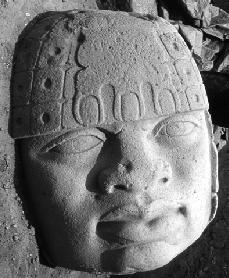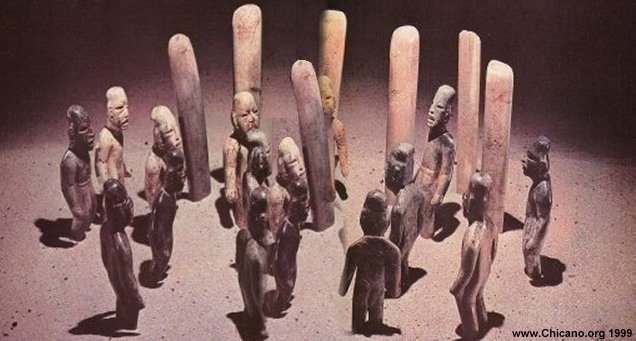

Skeletal Evidence of African Olmecs
By
Dr. Clyde A. Winters

Dr. Wiercinski (1972) claims that the some of the Olmecs were of African origin. He supports this claim with skeletal evidence from several Olmec sites where he found skeletons that were analogous to the West African type black. Wiercinski discovered that 13.5 percent of the skeletons from Tlatilco and 4.5 percent of the skeletons from Cerro de las Mesas were Africoid (Rensberger,1988; Wiercinski, 1972; Wiercinski & Jairazbhoy 1975).
Diehl and Coe (1995, 12) of Harvard University have made it clear that until a skeleton of an African is found on an Olmec site he will not accept the art evidence that the were Africans among the Olmecs. This is rather surprising because Constance Irwin and Dr. Wiercinski (1972) have both reported that skeletal remains of Africans have been found in Mexico. Constance Irwin, in Fair Gods and Stone Faces, says that anthropologist see "distinct sign
s of Negroid ancestry in many a New World skull...."Dr. Wiercinski (1972) claims that some of the Olmecs were of African origin. He supports this claim with skeletal evidence from several Olmec sites where he found skeletons that were analogous to the West African type black. Many Olmec skulls show cranial deformations (Pailles, 1980), yet Wiercinski (1972b) was able to determine the ethnic origins of the Olmecs. Marquez (1956, 179-80) made it clear that a common trait of the African skulls found in Mexico include marked prognathousness ,prominent cheek bones are also mentioned. Fronto-occipital deformation among the Olmec is not surprising because cranial deformations was common among the Mande speaking people until fairly recently (Desplanges, 1906).
Many African skeletons have been found in Mexico. Carlo Marquez (1956, pp.179-180) claimed that these skeletons indicated marked pronathousness and prominent cheek bones.

Here we see Olmec Priest at LaVenta with cranial deformations
Wiercinski found African skeletons at the Olmec sites of Monte Alban, Cerro de las Mesas and Tlatilco. Morley, Brainerd and Sharer (1989) said that Monte Alban was a colonial Olmec center (p.12).
Diehl and Coe (1996) admitted that the inspiration of Olmec Horizon A, common to San Lorenzo's iniitial phase has been found at Tlatilco. Moreover, the pottery from this site is engraved with Olmec signs.
According to Wiercinski (1972b) Africans represented more than 13.5 percent of the skeletal remains found at Tlatilco and 4.5 percent of the Cerro remains (see Table 2). Wiercinski (1972b) studied a total of 125 crania from Tlatilco and Cerro.
There were 38 males and 62 female crania in the study from Tlatilco and 18 males and 7 females from Cerro. Whereas 36 percent of the skeletal remains were of males, 64 percent were women (Wiercinski, 1972b).
To determine the racial heritage of the ancient Olmecs, Dr. Wiercinski (1972b) used classic diagnostic traits determined by craniometric and cranioscopic methods. These measurements were then compared to a series of three crania sets from Poland, Mongolia and Uganda to represent the three racial categories of mankind.
In Table 1, we have the racial composition of the Olmec skulls. The only European type recorded in this table is the Alpine group which represents only 1.9 percent of the crania from Tlatilco.
|
Table 1.Olmec Races |
|
|
|
Racial Type |
Tlatilco Norm Percent |
Cerro de Mesas Norm Percent |
|
Subpacific Dongolan Subainuid Pacific Armenoid Armenoid-Bushman Anatolian Alpine Ainuid Ainuid-Arctic Laponoid-Equatorial Pacific-Equatorial |
7 13.5 4 7.7 2 3.9 2 3.9 2 3.9 1 1.9 1 1.9 1 1.9 1 1.9
________________ 52 |
--- ---- 3 27.3 --- ---- --- ---- 1 9.1 --- --- --- --- --- --- --- --- --- --- --- --- ________________ 11 |
The other alleged "white" crania from Wiercinski's typology of Olmec crania, represent the Dongolan (19.2 percent), Armenoid (7.7 percent), Armenoid-Bushman (3.9 percent) and Anatolian (3.9 percent). The Dongolan, Anatolian and Armenoid terms are euphemisms for the so-called "Brown Race" "Dynastic Race", "Hamitic Race",and etc., which racist Europeans claimed were the founders of civilization in Africa.
|
Table 2: Racial Composition: Loponoid Armenoid Ainuid+Artic Pacific Equatorial+Bushman |
Tlatico 21.2 18.3 10.6 36.5 13.5 |
Cerro de las Mesas 31.8 4.5 13.6 45.5 4.5 |
Poe (1997), Keita (1993,1996), Carlson and Gerven (1979)and MacGaffey (1970) have made it clear that these people were Africans or Negroes with so-called 'caucasian features' resulting from genetic drift and microevolution (Keita, 1996; Poe, 1997). This would mean that the racial composition of 26.9 percent of the crania found at Tlatilco and 9.1 percent of crania from Cerro de las Mesas were of African origin.
In Table 2, we record the racial composition of the Olmec according to the Wiercinski (1972b) study. The races recorded in this table are based on the Polish Comparative-Morphological School (PCMS). The PCMS terms are misleading. As mentioned earlier the Dongolan , Armenoid, and Equatorial groups refer to African people with varying facial features which are all Blacks. This is obvious when we look at the iconographic and sculptural evidence used by Wiercinski (1972b) to support his conclusions.
Wiercinski (1972b) compared the physiognomy of the Olmecs to corresponding examples of Olmec sculptures and bas-reliefs on the stelas. For example, Wiercinski (1972b, p.160) makes it clear that the clossal Olmec heads represent the Dongolan type. It is interesting to note that the emperical frequencies of the Dongolan type at Tlatilco is .231, this was more than twice as high as Wiercinski's theorectical figure of .101, for the presence of Dongolans at Tlatilco.
The other possible African type found at Tlatilco and Cerro were the Laponoid group. The Laponoid group represents the Austroloid-Melanesian type of (Negro) Pacific Islander, not the Mongolian type. If we add together the following percent of the Olmecs represented in Table 2, by the Laponoid (21.2%), Equatorial (13.5), and Armenoid (18.3) groups we can assume that at least 53 percent of the Olmecs at Tlatilco were Africans or Blacks. Using the same figures recorded in Table 2 for Cerro,we observe that 40.8 percent of these Olmecs would have been classified as Black if they lived in contemporary America.
Rossum (1996) has criticied the work of Wiercinski because he found that not only blacks, but whites were also present in ancient America. To support this view he (1) claims that Wiercinski was wrong because he found that Negro/Black people lived in Shang China, and 2) that he compared ancient skeletons to modern Old World people.
First, it was not surprising that Wiercinski found affinities between African and ancient Chinese populations, because everyone knows that many Negro/African /Oceanic skeletons (referred to as Loponoid by the Polish school) have been found in ancient China see: Kwang-chih Chang The Archaeology of ancient China (1976,1977, p.76,1987, pp.64,68). These Blacks were spread throughout Kwangsi, Kwantung, Szechwan, Yunnan and Pearl River delta.
Skeletons from Liu-Chiang and Dawenkou, early Neolithic sites found in China, were also Negro. Moreover, the Dawenkou skeletons show skull deformation and extraction of teeth customs, analogous to customs among Blacks in Polynesia and Africa.
Secondly, Rossum argues that Wiercinski was wrong about Blacks in ancient America because a comparison of modern native American skeletal material and the ancient Olmec skeletal material indicate no admixture. The study of Vargas and Rossum are flawed. They are flawed because the skeletal reference collection they used in their comparison of Olmec skeletal remains and modern Amerindian propulations because the Mexicans have been mixing with African and European populations since the 1500's. This has left many components of these Old World people within and among Mexican Amerindians.
The iconography of the classic Olmec and Mayan civilization show no correspondence in facial features. But many contemporary Maya and other Amerind groups show African characteristics and DNA. Underhill, et al (1996) found that the Mayan people have an African Y chromosome. This would explain the "puffy" faces of contemporary Amerinds, which are incongruent with the Mayan type associated with classic Mayan sculptures and stelas.
Wiercinski on the otherhand, compared his SRC to an unmixed European and African sample. This comparison avoided the use of skeletal material that is clearly mixed with Africans and Europeans, in much the same way as the Afro-American people he discussed in his essay who have acquired "white" features since mixing with whites due to the slave trade.
A. von Wuthenau (1980), and Wiercinski (1972b) highlight the numerous art pieces depicting the African or Black variety which made up the Olmec people. This re-anlysis of the Olmec skeletal meterial from Tlatilco and Cerro, which correctly identifies Armenoid, Dongolan and Loponoid as euphmisms for "Negro" make it clear that a substantial number of the Olmecs were Blacks support the art evidence and writing which point to an African origin for Olmec civilization.
In conclusion, the Olmec people were called Xi. They did not speak a Mixe-Zoque language they spoke a Mande language, which is the substratum language for many Mexican languages.
The Olmec came from Saharan Africa 3200 years ago.They came in boats which are depicted in the Izapa Stela no.5, in twelve migratory waves. These Proto-Olmecs belonged to seven clans which served as the base for the Olmec people.
Physical anthropologist use many terms to refer to the African type represented by Olmec skeletal remains including Armenoid, Dongolan, Loponoid and Equatorial. The evidence of African skeletons found at many Olmec sites, and their trading partners from the Old World found by Dr. Andrzej Wiercinski prove the cosmopolitan nature of Olmec society. This skeletal evidence explains the discovery of many African tribes in Mexico and Central America when Columbus discovered the Americas (de Quatrefages, 1836).
The skeletal material from Tlatilco and Cerro de las Mesas and evidence that the Olmecs used an African writing to inscribe their monuments and artifacts, make it clear that Africans were a predominant part of the Olmec population. These Olmecs constructed complex pyramids and large sculptured monuments weighing tons. The Maya during the Pre-Classic period built pyramids over the Olmec pyramids to disguise the Olmec origin of these pyramids.
References
Carlson,D. and Van Gerven,D.P. (1979). Diffussion, biological determinism and bioculdtural adaptation in the Nubian corridor,American Anthropologist, 81, 561-580.
Desplagnes, M. (1906). Deux nouveau cranes humains de cites lacustres. L'Anthropologie, 17, 134-137.
Diehl, R. A., & Coe, M.D. (1995). "Olmec archaeology". In In Jill Guthrie (Ed.), Ritual and Rulership, (pp.11-25). The Art Museum: Princeton University Press.
Irwin,C.Fair Gods and Stone Faces.
Keita,S.O.Y. (1993). Studies and comments on ancient Egyptian biological relationships, History in Africa, 20, 129-131.
Keita,S.O.Y.& Kittles,R.A. (1997). The persistence of racial thinking and the myth of racial divergence, American Anthropologist, 99 (3), 534-544.
MacGaffey,W.(1970). Comcepts of race in Northeast Africa. In J.D. Fage and R.A. Oliver, Papers in African Prehistory (pp.99-115), Camridge: Cambridge University Press.
Marquez,C.(1956). Estudios arqueologicas y ethnograficas. Mexico.
Rensberger, B. ( September, 1988). Black kings of ancient America", Science Digest, 74-77 and 122.
Underhill,P.A.,Jin,L., Zemans,R., Oefner,J and Cavalli-Sforza,L.L.(1996, January). A pre-Columbian Y chromosome-specific transition and its implications for human evolutionary history, Proceedings of the National Academy of Science USA,93, 196-200.
Van Rossum,P. (1996). Olmec skeletons African? No, just poor scholarship.
http://copan.bioz.unibas.ch/meso/rossum.html.Von Wuthenau, Alexander. (1980). Unexplained Faces in Ancient America, 2nd Edition, Mexico 1980.
Wiercinski, A.(1969). Affinidades raciales de algunas poblaiones antiquas de Mexico, Anales de INAH, 7a epoca, tomo II, 123-143.
Wiercinski,A. (1972). Inter-and Intrapopulational Racial Differentiation of Tlatilco, Cerro de Las Mesas, Teothuacan, Monte Alban and Yucatan Maya, XXXlX Congreso Intern. de Americanistas, Lima 1970 ,Vol.1, 231-252.
Wiercinski,A. (1972b). An anthropological study on the origin of "Olmecs", Swiatowit ,33, 143-174.
Wiercinski, A. & Jairazbhoy, R.A. (1975) "Comment", The New Diffusionist,5 (18),5.
